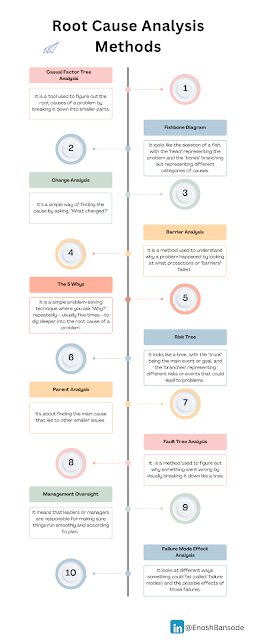Linkedin Post
1. A "casual factor tree analysis" is a tool used to figure out the root causes of a problem by breaking it down into smaller parts. Imagine it like a tree where the trunk is the main problem, and each branch represents different reasons that led to it.
2. A fishbone diagram, also known as a cause-and-effect diagram or Ishikawa diagram, is a tool used to identify the possible causes of a problem. It looks like the skeleton of a fish, with the "head" representing the problem and the "bones" branching out representing different categories of causes.
3. "Change analysis" is a method used to understand why a problem happened by looking at what changed. It compares the situation before and after the issue occurred to identify key differences.
4. Barrier analysis is a method used to understand why a problem happened by looking at what protections or "barriers" failed. Barriers are things put in place to prevent a problem, like safety measures, procedures, or equipment.
5. The 5 Whys is a simple problem-solving technique where you ask "Why?" repeatedly—usually five times—to dig deeper into the root cause of a problem.
6. A risk tree is a tool used to identify and analyze potential risks in a situation. It looks like a tree, with the "trunk" being the main event or goal, and the "branches" representing different risks or events that could lead to problems.
7. Parent analysis is a method used to trace back the cause of a problem to its "parent" or source. It's about finding the main cause that led to other smaller issues.
8. Fault tree analysis is a method used to figure out why something went wrong by visually breaking it down like a tree. The "top" of the tree represents the main problem or failure, and the branches below show all the possible causes that led to it.
9. Management oversight means that leaders or managers are responsible for making sure things run smoothly and according to plan. It involves supervising tasks, monitoring progress, and ensuring that everyone follows rules and procedures.
10. Failure Mode Effect Analysis (FMEA) is a tool used to identify potential problems before they happen. It looks at different ways something could fail (called "failure modes") and the possible effects of those failures.
programming coding softwaredevelopment systemdesign CICD
Saturday, June 21, 2025
Apache Kafka usecases
Linkedin Post
Real-Time Data Streaming
A shopping website uses Kafka to track users' clicks on or buys in real time for better recommendations.
Event-Driven Architectures
When a customer places an order, Kafka sends events to different services like payments, inventory, and shipping without them needing to talk to each other directly.
Log Aggregation
A company uses Kafka to collect error logs from different servers in real time, making finding and fixing issues easier.
Data Integration and ETL
Streaming data from a sales system to a reporting tool so the company can analyze sales in real-time.
Metrics and Monitoring
Streaming server health data to a dashboard to track performance and spot issues quickly.
Message Queue Replacement
A stock trading platform uses Kafka to make sure trade orders are processed quickly and accurately.
hashtag#Apache hashtag#kafka hashtag#programming hashtag#coding hashtag#eventdrivenarchitecture
How to accept feedback effectively?
Linkedin Post
Here’s a simple guide on how to accept feedback effectively:
1. Have an open mind: Approach feedback with an open mind. Remember, feedback is meant to help you grow, not to criticize you.
2. Listen Actively: Let the person speak without interrupting. Focus on understanding, not defending.
3. Acknowledge: Thank the person for their input, even if it’s hard to hear. Showing appreciation encourages more feedback in the future.
4. Clarify: If something is unclear, ask questions. Seek specifics like, “Can you give an example?” or “Could you elaborate on that?”
5. Don’t Take it Personally: Try to separate the feedback from yourself as a person. The feedback is about improving your actions or work, not a judgment of who you are.
6. Reflect: Take time to process the feedback. You don’t need to agree with everything immediately. Reflect on what was said and how it applies.
7. Act on it: Implement the relevant feedback. This shows you’re serious about improvement.
8. Follow-up: If possible, update the person on how you’ve applied their feedback. It shows you value their opinion and helps build a culture of continuous improvement.
Accepting feedback is an essential skill, especially for growth-oriented leaders like yourself.
hashtag#managers
hashtag#engineeringmanagers
hashtag#peoplemanagers
hashtag#leadership
hashtag#leader
hashtag#LeadershipDevelopment
hashtag#strategicthinking
hashtag#techtopics
Subscribe to:
Posts (Atom)


